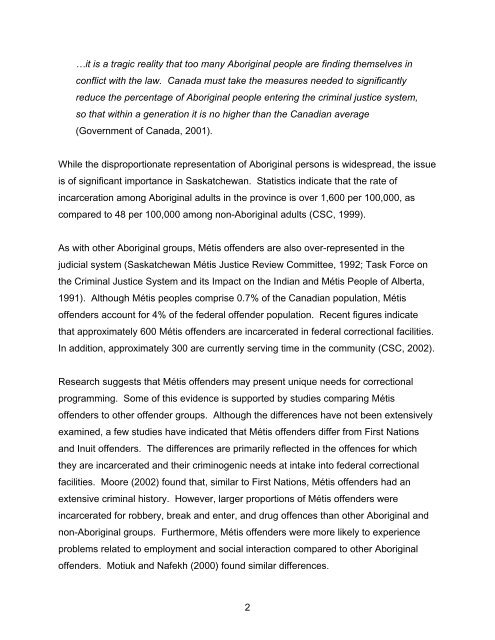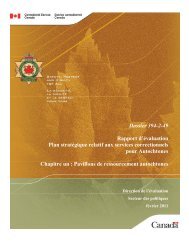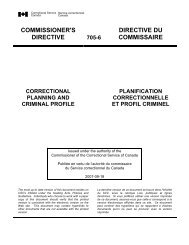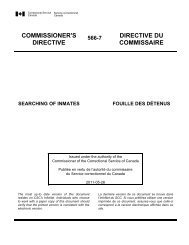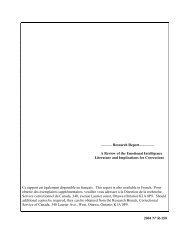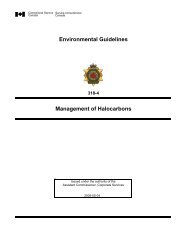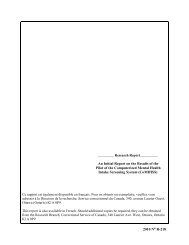Program and Service Needs of Federally Incarcerated Métis ...
Program and Service Needs of Federally Incarcerated Métis ...
Program and Service Needs of Federally Incarcerated Métis ...
Create successful ePaper yourself
Turn your PDF publications into a flip-book with our unique Google optimized e-Paper software.
…it is a tragic reality that too many Aboriginal people are finding themselves in<br />
conflict with the law. Canada must take the measures needed to significantly<br />
reduce the percentage <strong>of</strong> Aboriginal people entering the criminal justice system,<br />
so that within a generation it is no higher than the Canadian average<br />
(Government <strong>of</strong> Canada, 2001).<br />
While the disproportionate representation <strong>of</strong> Aboriginal persons is widespread, the issue<br />
is <strong>of</strong> significant importance in Saskatchewan. Statistics indicate that the rate <strong>of</strong><br />
incarceration among Aboriginal adults in the province is over 1,600 per 100,000, as<br />
compared to 48 per 100,000 among non-Aboriginal adults (CSC, 1999).<br />
As with other Aboriginal groups, <strong>Métis</strong> <strong>of</strong>fenders are also over-represented in the<br />
judicial system (Saskatchewan <strong>Métis</strong> Justice Review Committee, 1992; Task Force on<br />
the Criminal Justice System <strong>and</strong> its Impact on the Indian <strong>and</strong> <strong>Métis</strong> People <strong>of</strong> Alberta,<br />
1991). Although <strong>Métis</strong> peoples comprise 0.7% <strong>of</strong> the Canadian population, <strong>Métis</strong><br />
<strong>of</strong>fenders account for 4% <strong>of</strong> the federal <strong>of</strong>fender population. Recent figures indicate<br />
that approximately 600 <strong>Métis</strong> <strong>of</strong>fenders are incarcerated in federal correctional facilities.<br />
In addition, approximately 300 are currently serving time in the community (CSC, 2002).<br />
Research suggests that <strong>Métis</strong> <strong>of</strong>fenders may present unique needs for correctional<br />
programming. Some <strong>of</strong> this evidence is supported by studies comparing <strong>Métis</strong><br />
<strong>of</strong>fenders to other <strong>of</strong>fender groups. Although the differences have not been extensively<br />
examined, a few studies have indicated that <strong>Métis</strong> <strong>of</strong>fenders differ from First Nations<br />
<strong>and</strong> Inuit <strong>of</strong>fenders. The differences are primarily reflected in the <strong>of</strong>fences for which<br />
they are incarcerated <strong>and</strong> their criminogenic needs at intake into federal correctional<br />
facilities. Moore (2002) found that, similar to First Nations, <strong>Métis</strong> <strong>of</strong>fenders had an<br />
extensive criminal history. However, larger proportions <strong>of</strong> <strong>Métis</strong> <strong>of</strong>fenders were<br />
incarcerated for robbery, break <strong>and</strong> enter, <strong>and</strong> drug <strong>of</strong>fences than other Aboriginal <strong>and</strong><br />
non-Aboriginal groups. Furthermore, <strong>Métis</strong> <strong>of</strong>fenders were more likely to experience<br />
problems related to employment <strong>and</strong> social interaction compared to other Aboriginal<br />
<strong>of</strong>fenders. Motiuk <strong>and</strong> Nafekh (2000) found similar differences.<br />
2


